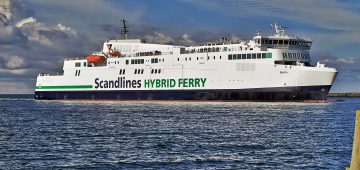Fast Turbine Powered Silver Line Cargo-Liners

 This trio of cargo-liners were the first turbine powered vessels built for Silver Line. Silverlaurel of 9,600 dwt was completed in March 1939, and was followed post-war by the beautiful twin funnelled Silverbriar of 10,160 dwt in February 1948 and her sister Silverplane a few months later. A partnership had been formed in 1908 between the brothers Stanley and John Thompson to act as the managing owners of the new St. Helen’s Steamshipping Co. Ltd. of London. The company owned one tramp, Wearmouth, which was soon renamed Silverbirch.
This trio of cargo-liners were the first turbine powered vessels built for Silver Line. Silverlaurel of 9,600 dwt was completed in March 1939, and was followed post-war by the beautiful twin funnelled Silverbriar of 10,160 dwt in February 1948 and her sister Silverplane a few months later. A partnership had been formed in 1908 between the brothers Stanley and John Thompson to act as the managing owners of the new St. Helen’s Steamshipping Co. Ltd. of London. The company owned one tramp, Wearmouth, which was soon renamed Silverbirch.
The Thompson brothers were members of the famous Sunderland shipbuilding family of Joseph L. Thompson & Sons Ltd., and other members of the family owned tramps in Sunderland. Farringford was purchased from Charlton & Thompson in Sunderland to become Silverash, and the Burrell tramp Fitzpatrick was purchased in 1913 to become Silvercedar. The finances of the company were reorganised for expansion in 1912, and then a management contract was entered into in 1913 with the America-Levant Line, whose directors included Sir Alfred Allen Booth and the Catto family of shipowners. Former British tramps included the Burrell Fitzclarence renamed with ‘River’ names, and were used for Transatlantic services, a contract that was to run until 1930.
Silver Line Ltd.
In 1926, the main project of H. Farquath Kerr of the Kerr Steamship Co. Ltd. of New York was developed into Silver Line Ltd., in which he was the main shareholder. Most of the required capital was obtained from British sources under the Trade Facilities Acts. The early westbound Round the World service with Kerr owned ships was then taken over by Silver Line and Prince Line operating jointly with alternate sailings. The only other American competition was Dollar Line of New York, but British competition came from James Chambers of Liverpool and his Lancashire Shipping Co. Ltd. with ‘Castle’ ships, as well as Bank Line to the Pacific islands. Kerr eventually disposed of his own ships and he died in 1933, selling his shares to Alfred E. Clegg.
Silver Java Pacific Line
In October 1930, Silver Line came to a merger agreement with the Java Pacific Company, established in 1903 and later known as Java-China-Japan Line (JCJL) with cargo-liners with ‘Tji’ as a prefix, and their combined fleets took the name of Silver Java Pacific Line. The General Steamship Company of San Francisco was their American agent, and a fleet of thirteen Silver Line ships and seven Dutch ships then operated on three distinct monthly services in addition to the westbound Silver Prince Round the World service. These services were:-

(1) Pacific Coast of U.S.A. and Canada to the Philippines, Dutch East Indies, Straits ports, and India.
(2) Eastbound Round the World via Panama, South Africa, India, Dutch East Indies and the Philippines.
(3) Pacific Coast of U.S.A. and Canada to the Philippines, Dutch East Indies, Straits ports, Ceylon, Bombay and the Persian Gulf.
Sign-up today to read the full article!
Simply click below to sign-up and read the full article, as well as many others, instantly!





Comments
Sorry, comments are closed for this item